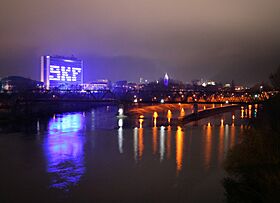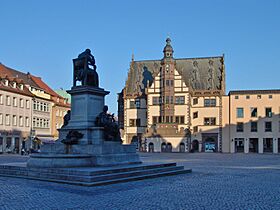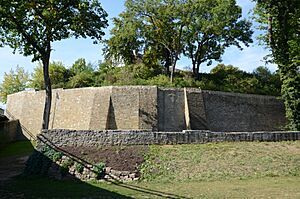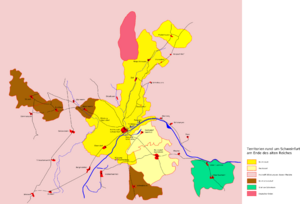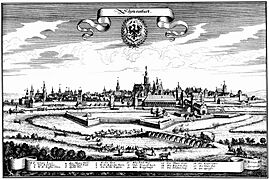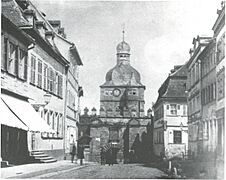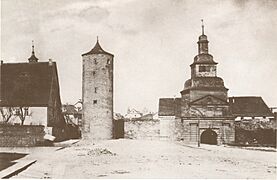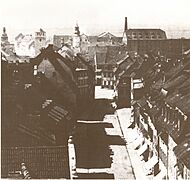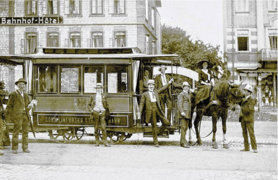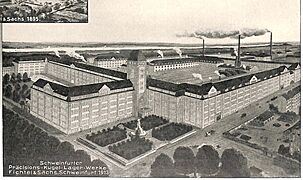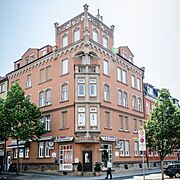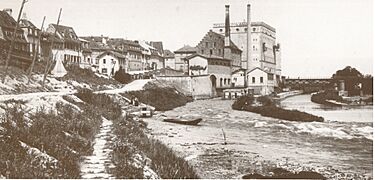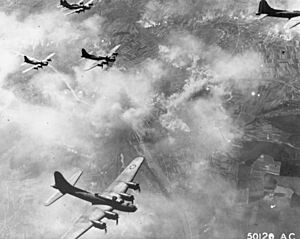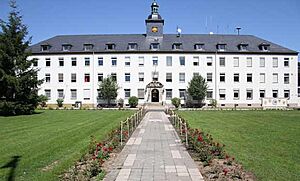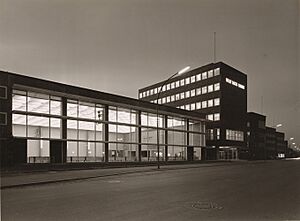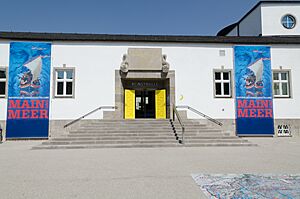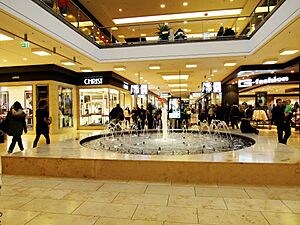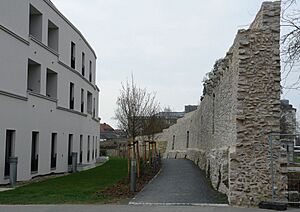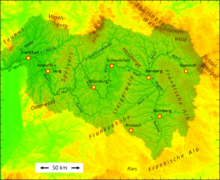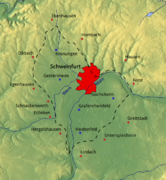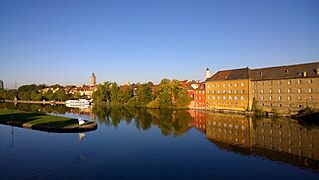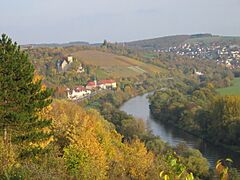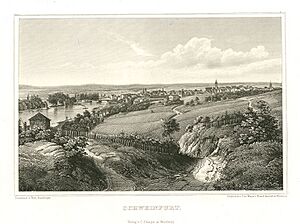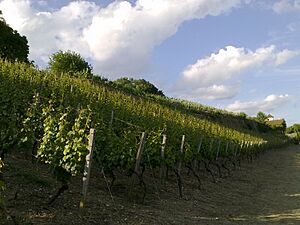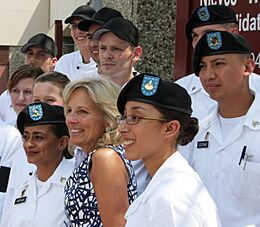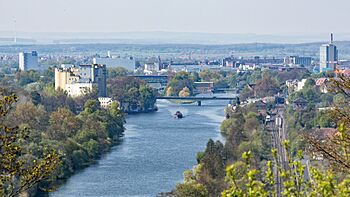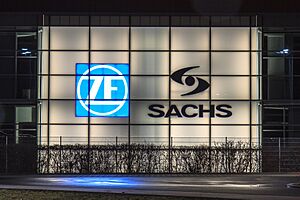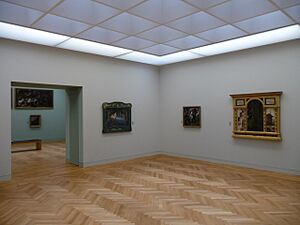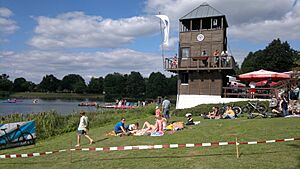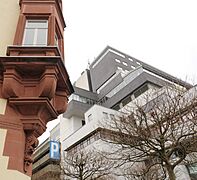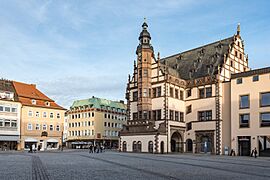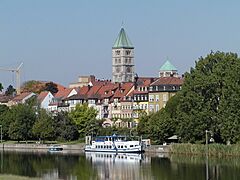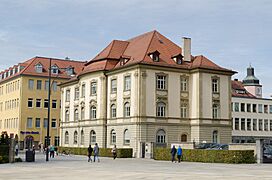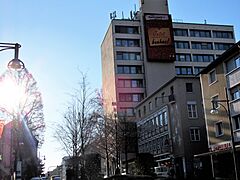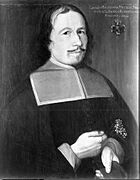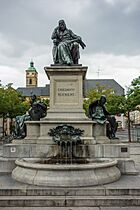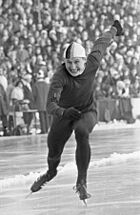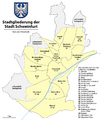Schweinfurt facts for kids
Quick facts for kids
Schweinfurt
|
|||
|---|---|---|---|
|
Clockwise from top: Skyline at night, Maininsel Conference Center, Willy-Sachs-Stadion, Marketplace with the Old Town Hall, Museum Georg Schäfer, Art Gallery
|
|||
|
|||
| Country | Germany | ||
| State | Bavaria | ||
| Admin. region | Lower Franconia | ||
| District | Urban district | ||
| Elevation | 226 m (741 ft) | ||
| Population
(2022-12-31)
|
|||
| • Total | 54,675 | ||
| Time zone | CET/CEST (UTC+1/+2) | ||
| Postal codes |
97421–97424
|
||
| Dialling codes | 09721 | ||
| Vehicle registration | SW | ||
| Website | www.schweinfurt.de | ||
Schweinfurt is a city in Bavaria, Germany. It's located in the Lower Franconia region and is an important center for industry, culture, and education. The city's name means 'swine ford', referring to a place where pigs could cross a river. About 100,200 people live in the wider city area.
Schweinfurt is one of the oldest cities in Bavaria, first mentioned in the year 791. For many centuries, from the 1100s to 1802, it was a Free imperial city within the Holy Roman Empire. This meant it was self-governing and answered directly to the Emperor. The city has a long history of industry, which began around 1770.
During World War II, Schweinfurt was a major target for air raids because it produced many ball bearings, which were vital for tanks and aircraft. The city suffered a lot of damage. After the war, it became a significant base for the U.S. Army until 2014.
Today, Schweinfurt is a key transport hub in Germany. It has a very high number of jobs compared to its population and is known for its strong economy. Many large companies, including SKF, Schaeffler, ZF Friedrichshafen, and Fresenius Medical Care, have big factories here. Important inventions like the pedal bike, the freewheel, and the coaster brake came from Schweinfurt. The German National Academy of Sciences Leopoldina, the oldest science academy in the world that's still running, was founded here in 1652.
Contents
- Schweinfurt: A City of History and Industry
- Early History and Beginnings
- From Medieval Walls to Imperial City Growth
- Reformation, Wars, and New Beginnings
- Industrial Growth and Modernization
- Schweinfurt During World War II
- Post-War Recovery and U.S. Army Presence
- Rebuilding and Modern Schweinfurt
- The Grieser Era: Industry Meets Art
- Schweinfurt Today
- Geography and Location
- Population and Demographics
- Economy and Industry
- Community Facilities
- Culture and Architecture
- Sister Cities
- Notable People
- Climate
- Images for kids
- See also
Schweinfurt: A City of History and Industry
Early History and Beginnings
People have lived in the area of Schweinfurt for a very long time, with traces of settlements found from about 7,500 years ago. The first known settlement of historic Schweinfurt was by the Main River, about 1 kilometer east of where the old town is today. This early village is at least 2,100 years old.
The city of Schweinfurt was first officially mentioned in the year 791. It became more important in 941 when Count Berthold of Schweinfurt was noted as a powerful figure in the region. His family, the Counts of Schweinfurt, controlled large parts of northern Bavaria.
Later, Count Henry of Schweinfurt supported Henry II of Germany in becoming king in 1002. However, Henry II didn't keep his promise to make Count Henry a duke, which led to a conflict called the "Schweinfurt Feud" in 1003. Count Henry lost many of his lands, and these lands became part of the new bishopric of Bamberg. The family's important role ended around 1057.
The current old town of Schweinfurt started to be built in the 12th century, about 1 kilometer west of the earlier settlement. It's believed that Emperor Frederick I Barbarossa helped plan this new city. Between 1240 and 1250, the city was damaged during a conflict. In 1254, a letter from King William II of Holland mentioned Schweinfurt as a former imperial city, confirming its city rights.
From Medieval Walls to Imperial City Growth
The inner city walls of the new city were built and first recorded in 1258. Many parts of these walls can still be seen today. In 1282, a document signed by Rudolf I of Habsburg confirmed that Schweinfurt was a free city within the Holy Roman Empire. This meant it was independent and governed itself.
In the 15th century, Schweinfurt began to expand its territory around the main city. In 1436, the fishing village of Fischerrain, located next to the city wall, became part of Schweinfurt. The city also bought the suburb of Oberndorf in the same year. In 1436-1437, the city council bought a castle and land from the Teutonic Knights, including the villages of Zell and Weipoltshausen.
Reformation, Wars, and New Beginnings
Schweinfurt joined the Reformation in 1542, becoming a Protestant city. This was a big step because the city was surrounded by Catholic areas, and changing religions could lead to military attacks.
In 1554, during the Second Margrave War, the city was looted and set on fire. This event is known as the "Second City Spoilage." The rebuilding of the city took a long time, lasting until 1615. The old town kept this rebuilt look until the early 1800s. In 1609, the city joined the Protestant Union.
During the Thirty Years' War, Schweinfurt was occupied by Gustavus Adolphus, who built new defenses. Some parts of these defenses still exist. In 1652, four doctors in Schweinfurt founded the Academia Curiosorum, which is now known as the German National Academy of Sciences Leopoldina. It's the oldest continuously existing natural science academy in the world.
Schweinfurt remained a free imperial city until 1802, when it became part of Bavaria. In 1810, it was given to the Grand Duchy of Würzburg, but four years later, it returned to the Kingdom of Bavaria.
- Schweinfurt with buildings after the Second Margrave War
-
Imperial City of Schweinfurt 1648
Matthäus Merian, Frankfurt a. M.
Industrial Growth and Modernization
The year 1770 marked the start of Schweinfurt's industrial age, which has now lasted for 250 years. The chemical and paint industries were among the first to develop here. The Wolf's lead white mill, built by the river, was one of Germany's oldest lead white factories.
In 1803, Schweinfurt officially became part of Bavaria. Many people protested this change. The villages that belonged to the imperial city were separated, and Schweinfurt lost about two-thirds of its land.
In 1852, Schweinfurt was connected to the railway network. It became an important railway hub with new lines built in the 1870s. A large central station, now called Schweinfurt Hauptbahnhof, was built outside the city center to allow for future industrial growth. From 1895 to 1921, Schweinfurt even had its own tram system, the first municipal tram in Bavaria.
- Schweinfurt in the ''Gründerzeit'' in the Kingdom of Bavaria
The 1930s were a time of major growth for Schweinfurt. The number of people working in metalworking companies grew to 20,700 by 1939. This led to a building boom and helped shape the city's modern look.
Schweinfurt During World War II
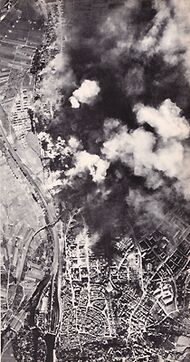

By 1939, Schweinfurt was producing most of Nazi Germany's ball bearings. Because of this, the city's factories became a main target for Allied air raids during World War II. The goal was to damage Germany's ability to produce tanks and aircraft. Schweinfurt was bombed 22 times.
One of the most significant attacks was the Second Raid on Schweinfurt in October 1943. While the bombings caused a lot of damage to factories and homes, and many civilians lost their lives, German efforts to repair and rebuild the factories were very strong. They even moved some production underground to protect it.
On April 11, 1945, the U.S. Army entered Schweinfurt, and there was fighting in the city.
Post-War Recovery and U.S. Army Presence
After the war, Schweinfurt became an important base for the U.S. military. This helped the city recover quickly from the wartime destruction. The Ledward Barracks became the headquarters for the U.S. Army Garrison Schweinfurt. The U.S. Army also took over the former air base, renaming it Conn Barracks.
Over time, a complete American-style town was built in the northwest of Schweinfurt, with shops and services for about 12,000 American soldiers and civilians. Schweinfurt became one of the largest U.S. military locations in Europe. The U.S. Army Garrison Schweinfurt closed on September 19, 2014, as the U.S. military reduced its presence in Germany.
Rebuilding and Modern Schweinfurt
Despite the wartime damage, Schweinfurt quickly rebuilt. Like many other cities in West Germany, it experienced a strong economic boom in the 1950s and 1960s. To deal with a shortage of workers, people from other countries were invited to work here starting in 1960.
Many new building projects happened under Mayor Georg Wichtermann (1965–1974). New neighborhoods were built, and industrial areas like "Port East" and "Port West" developed south of the Main River. Important facilities like the Main Port (1963) and the University of Applied Sciences Würzburg-Schweinfurt (1971) were also established.
From 1979, the old town began a long renovation project. This helped change the city's image from just an industrial city to a place with a high quality of life. In 1991, the large Leopoldina Hospital opened.
The Grieser Era: Industry Meets Art
In 1992, Gudrun Grieser became the Lord Mayor, bringing a new focus to the city. The city's economy became stronger, with many new jobs created in industry and services.
During Grieser's time, Schweinfurt adopted the motto "Industry and Art." Many new projects were completed, giving the city a fresh look and earning architectural awards. These projects included:
- The new Industrial Park Gewerbepark Maintal (since 1995)
- The Museum Georg Schäfer (2000)
- The Maininsel Conference Center (2004)
- The Stadtbücherei Ebracher Hof (city library, 2007)
- The Kunsthalle Schweinfurt (art gallery, 2009)
- The Stadtgalerie Schweinfurt, a long shopping mall (2009)
- The new Schweinfurt Mitte station
- The Youth Hostel (2009)
- The Health Park Schweinfurt (2009)
- Campus 2 of the University of Applied Sciences Würzburg-Schweinfurt
In 1998, German and American veterans and survivors of the bombings came together to build a war memorial. In 2004, the Unterfrankenshuttle regional train service started, connecting Schweinfurt to other parts of the region.
Schweinfurt Today
Under the current mayor, Sebastian Remelé (since 2010), the city has continued to grow. Schweinfurt is now working on a large project to reuse the former U.S. Army areas. This includes the i-Campus Schweinfurt in the old Ledward Barracks and a new district called Bellevue.
Geography and Location
Where is Schweinfurt?
Schweinfurt is located in the middle of Germany, about 40 kilometers from the borders of Baden-Württemberg, Hesse, and Thuringia. It sits on the Main River, which is connected to the North Sea and the Black Sea through the Rhine-Main-Danube Canal. The city is between the larger cities of Frankfurt (110 km west) and Nuremberg (90 km southeast), both of which have international airports.
Schweinfurt is also in the Franconian wine region, near the Schweinfurter Rhön. It's surrounded by beautiful natural areas like the Haßberge Hills, Steigerwald, Rhön, and Spessart, which include several natural parks and a biosphere reserve.
The city itself has many different types of areas. The eastern part, with its old town and many houses, is on the hills of the Schweinfurter Rhön. The western part, with the city center and main station, has a higher number of people from different backgrounds. The southern part is mostly a large industrial area.
Improved Connections
After the fall of the Iron Curtain in 1990, Schweinfurt's location became even more central. New highways and high-speed train lines have made it much faster to travel to other major German cities like Berlin, Munich, and Hamburg. For example, you can now reach Berlin in under three and a half hours from Schweinfurt.
Vineyards and Districts
Wine has been made in Schweinfurt for over 1,000 years. In the early 1800s, Schweinfurt was an important wine-growing and trading town, with about 320 hectares of vineyards. Many parts of the city today, even near the old town, used to be vineyards. The famous writer Goethe enjoyed Schweinfurt wine.
Today, there are only about 3.54 hectares of vineyards left, so wine production is not a big part of the economy anymore. However, it's still important for the city's culture and identity. Since the 1980s, winegrowing has been restarted in historic areas like Peterstirn and Mainleite. There's a family-owned winery at Peterstirn, which hosts a wine festival twice a year.
Schweinfurt is divided into 23 statistical districts, grouped into 15 main districts. The Bergl district used to be the most populated, but now the city center has the most residents.
Population and Demographics
In 1939, Schweinfurt had about 49,000 people. Its population reached its highest point in 1970 with 58,500 residents. After that, the population decreased to about 51,600 in 2014, which was the lowest since the early 1950s.
However, since 2015, the number of people living in Schweinfurt has been growing steadily. This is due to several factors, including refugees and new developments like the i-Campus Schweinfurt. By the end of 2018, the population had risen to 54,032.
It's important to note that the official population numbers do not include the U.S. Army soldiers and their families who were stationed in Schweinfurt between 1945 and 2014. At times, there were over 12,000 Americans living in and near the city.
The wider urban area of Schweinfurt had 100,200 inhabitants in 2018.
| Historical population | ||||||||||||||||||||||||||||||||||||||||||||||||||||||||||||||||||||||||||||||
|---|---|---|---|---|---|---|---|---|---|---|---|---|---|---|---|---|---|---|---|---|---|---|---|---|---|---|---|---|---|---|---|---|---|---|---|---|---|---|---|---|---|---|---|---|---|---|---|---|---|---|---|---|---|---|---|---|---|---|---|---|---|---|---|---|---|---|---|---|---|---|---|---|---|---|---|---|---|---|
|
|
|
||||||||||||||||||||||||||||||||||||||||||||||||||||||||||||||||||||||||||||
| Bold: highest level Red: lowest since the early 1950s |
||||||||||||||||||||||||||||||||||||||||||||||||||||||||||||||||||||||||||||||
Economy and Industry
Schweinfurt is famous for its metal industry, especially for making ball bearings. Major companies like FAG Kugelfischer AG, ZF Sachs AG, Bosch Rexroth, and SKF have large plants here. The city also produces the pigment Schweinfurt Green. SRAM Corporation has the world's biggest development center for bicycle parts in Schweinfurt.
Schweinfurt has a very high GDP per capita (Gross Domestic Product per person), ranking third in Germany. This shows how productive and wealthy the city is.
Studies have shown that Schweinfurt is one of the fastest-growing cities in Germany. It has a very high number of jobs, especially in the high-tech sector. It's also considered one of the most dynamic cities in Europe for new opportunities.
Major Companies in Schweinfurt
- Bosch Rexroth: A plant for linear motion technology.
- Carl Kühne KG: One of Germany's largest production sites for food products.
- Fresenius Medical Care: The biggest production and development location for this large healthcare company.
- Schaeffler Group: The second largest rolling bearing group in the world, with its biggest factory in Schweinfurt.
- Swedish ball bearing factories SKF: The largest rolling bearing group globally, with its biggest plant in Schweinfurt.
- SenerTec: A European leader in small power plants.
- SRAM: European headquarters for bicycle components.
- Winora Staiger: A bicycle manufacturer.
- ZF Friedrichshafen: The second largest automotive supplier in the world, with its largest factory in Schweinfurt.
Community Facilities
Schweinfurt offers many facilities for its residents:
- University of Applied Sciences Würzburg-Schweinfurt (FHWS) with the international i-Campus Schweinfurt.
- Fraunhofer Institute for Production Technology and Automation IPA.
- An academic teaching hospital.
- Many schools, including high schools, technical colleges, and vocational schools.
- A school of music.
- Libraries.
- Museums and art galleries.
- A theater.
- Many parks and green spaces.
- Golf courses.
- A rowing regatta stretch.
- Public swimming pools and an indoor swimming pool.
- A swimming lake and a city beach.
- Waterfront areas along the Main River.
Culture and Architecture
Cityscape and Buildings
Schweinfurt has a mix of old and new buildings, creating an interesting cityscape.
Main Attractions
Some of Schweinfurt's most important landmarks and sights include:
- The St. Johannes Church: First mentioned in 1237, this church shows many different architectural styles from over the centuries. Its Gothic choir dates back to the early 15th century.
- The Ebracher Hof: A beautiful Renaissance building from 1578. The Schweinfurt City Library moved into this building in 2006 after it was carefully renovated.
- The Old Town Hall: Built between 1570 and 1572, it's one of Germany's most famous Renaissance town halls.
- The Old Grammar School: Built in 1582–1583, this building now houses the local museum.
- The Museum Georg Schäfer (MGS): This museum has a special collection of 19th-century German paintings. It holds the world's largest collection of works by Carl Spitzweg, famous for his painting The Bookworm.
- The Museum Otto Schäfer (MOS): This museum features rare books, graphic arts, and applied arts, including the famous Schedel's Chronicle of the World from 1493. It also has works by famous artists like Albrecht Dürer and Lucas Cranach the Elder.
- The Kunsthalle Schweinfurt (art gallery): This gallery hosts temporary exhibitions. In 2013/2014, it showed the Gunter Sachs Collection, which included works by international pop art artists like Andy Warhol and Roy Lichtenstein.
- The Sachs-Stadion: A multi-functional football stadium designed by Paul Bonatz. It has been the home stadium for the 1. FC Schweinfurt 05 football club since 1936.
The marketplace in the city center has a large monument to the poet Friedrich Rückert. This square is used for weekly markets and many city festivals. The Stadtgalerie Schweinfurt, a 300-meter-long shopping mall, opened in 2009.
Motherwell Park and Châteaudun Park connect the old medieval buildings to the modern parts of the old town.
Music Scene
Vendetta, a thrash metal band, was formed in Schweinfurt in 1984.
Sister Cities
Schweinfurt has sister city relationships with:
 Châteaudun, France
Châteaudun, France North Lanarkshire, Scotland, United Kingdom
North Lanarkshire, Scotland, United Kingdom Seinäjoki, Finland
Seinäjoki, Finland
Notable People
Public Service and Business
- Judith of Schweinfurt (before 1003–1058), a duchess.
- Jacob Haylmann (1475–1526), an architect.
- Georg Balthasar Metzger (1623–1687), a doctor and founding member of the German National Academy of Sciences Leopoldina.
- Andreas Mechwart (1834–1907), an engineering pioneer.
- Theodor Fischer (1862–1938), an architect and professor.
- Albert Betz (1885–1968), a physicist.
- Georg Schäfer (1896–1975), an industrialist and art collector.
- Gerhard Eck (born 1960), a politician.
- Ivo Welch (born 1963), an economist and university lecturer.
- Sven Kesselring (born 1966), a sociologist and university professor.
Arts and Culture
- Wolfgang Carl Briegel (1626–1712), a composer and organist who worked in Schweinfurt.
- Johann Lorenz Bach (1695–1773), a composer and organist.
- Friedrich Rückert (1788–1866), a famous poet and translator.
- Adam Darr (1811–1866), a composer.
- Gunter Sachs (1932–2011), an art collector and photographer.
- Paul Maar (born 1937), a well-known children's book author.
- Tommy Jaud (born 1970), a screenwriter and novelist.
- Michael Wollny (born 1978), a jazz pianist and professor.
Sports Personalities
- Albin Kitzinger (1912–1970), a footballer who played for the German national team.
- Robert Bernard (1913–1990), a footballer who played for the German national team.
- Andreas Kupfer (1914–2001), a footballer who played for the German national team.
- Edi Ziegler (1930–2020), a road racing cyclist.
- Günter Bernard (born 1939), a footballer who played for the German national team.
- Günter Traub (born 1939), a speed skater.
- Remig Stumpf (1966–2019), a cyclist.
- Stephan Schröck (born 1986), a footballer who plays for the Philippines national team.
- Thomas Meissner (born 1991), a footballer.
- Johannes Geis (born 1993), a footballer.
- Dominik Bokk (born 2000), an ice hockey player.
Climate
| Climate data for Bad Kissingen , (1991–2020 normals) | |||||||||||||
|---|---|---|---|---|---|---|---|---|---|---|---|---|---|
| Month | Jan | Feb | Mar | Apr | May | Jun | Jul | Aug | Sep | Oct | Nov | Dec | Year |
| Mean daily maximum °C (°F) | 3.3 (37.9) |
5.0 (41.0) |
9.9 (49.8) |
15.3 (59.5) |
19.4 (66.9) |
22.7 (72.9) |
25.0 (77.0) |
24.7 (76.5) |
19.7 (67.5) |
13.6 (56.5) |
7.3 (45.1) |
3.8 (38.8) |
14.1 (57.4) |
| Daily mean °C (°F) | 0.7 (33.3) |
1.5 (34.7) |
5.1 (41.2) |
9.5 (49.1) |
13.5 (56.3) |
16.8 (62.2) |
18.7 (65.7) |
18.2 (64.8) |
13.8 (56.8) |
9.1 (48.4) |
4.5 (40.1) |
1.5 (34.7) |
9.4 (48.9) |
| Mean daily minimum °C (°F) | −1.9 (28.6) |
−1.8 (28.8) |
0.8 (33.4) |
3.9 (39.0) |
7.7 (45.9) |
11.0 (51.8) |
12.9 (55.2) |
12.5 (54.5) |
8.9 (48.0) |
5.4 (41.7) |
2.0 (35.6) |
−0.8 (30.6) |
5.1 (41.2) |
| Average precipitation mm (inches) | 59.5 (2.34) |
45.0 (1.77) |
45.1 (1.78) |
34.2 (1.35) |
60.6 (2.39) |
58.7 (2.31) |
76.6 (3.02) |
59.2 (2.33) |
49.3 (1.94) |
53.3 (2.10) |
56.9 (2.24) |
68.7 (2.70) |
665.8 (26.21) |
| Average precipitation days (≥ 1.0 mm) | 16.4 | 13.8 | 14.1 | 11.9 | 13.4 | 14.0 | 14.5 | 13.5 | 12.1 | 15.3 | 16.5 | 18.1 | 173.1 |
| Average snowy days (≥ 1.0 cm) | 9.8 | 6.7 | 2.3 | 0.1 | 0 | 0 | 0 | 0 | 0 | 0 | 1.3 | 5.2 | 25.4 |
| Average relative humidity (%) | 85.4 | 81.3 | 75.0 | 67.8 | 70.7 | 70.9 | 70.8 | 72.2 | 78.6 | 85.7 | 88.9 | 88.5 | 78.0 |
| Mean monthly sunshine hours | 42.0 | 70.7 | 121.4 | 176.8 | 204.2 | 217.2 | 226.5 | 209.2 | 148.9 | 92.2 | 39.6 | 28.6 | 1,590.8 |
| Source: World Meteorological Organization | |||||||||||||
Images for kids
See also
 In Spanish: Schweinfurt (Alemania) para niños
In Spanish: Schweinfurt (Alemania) para niños


